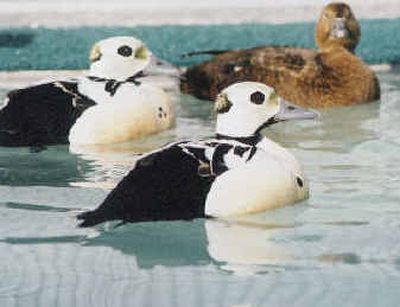Breeding program for rare sea ducks doesn’t work yet

ANCHORAGE, Alaska – Researchers at the Alaska Sealife Center are getting an education in the sex lives of a rare sea duck species that is disappearing from its nesting grounds in Alaska.
Ten male and seven female Steller’s eiders were collected from the Alaska Peninsula and Aleutian Islands in 2003 and installed in a large outdoor pen at the Seward center as part of a federally funded captive breeding program.
Researchers have observed the sea ducks for a year. To help get the ducks in the mood this spring, their 25-foot-by-60-foot pen was converted into something more cozy, with tundra grasses, moss, pebbles, driftwood and natural barriers for increased privacy.
Then, the researchers watched and waited.
“We saw courtship behavior, such as mating displays including head throws, bill lifts – typical eider mating behavior that we know of from the wild,” said Tuula Hollmen, the center’s eider program manager.
The ducks did some body bumps, waddling and wing flapping – all encouraging signs that the sexes were getting along swimmingly.
The males acted interested. They called out to the females, who appeared willing, some even preparing for family by eating more and bulking up. One had a distended abdomen indicating her ovaries were gearing up for motherhood. One went so far as to place some feathers in a nest.
In the end, the males apparently were a bit shy. No olive-colored eggs were produced. The males – which in breeding plumage have a black back, white shoulders, chestnut breast and belly, and a white head with a green tuft and black eye patches – reverted to an ordinary brown.
“I would say that the females were more ready than the males,” said Heidi Weingartz, the center’s avian curator. “If it was up to the girls, there would be a lot more babies around.”
Weingartz and Hollmen are optimistic about trying again next spring.
“This is totally new, breeding this particular species in captivity … They already went way beyond our expectations this year,” Weingartz said. “It is very difficult to figure out what it was that made them happy but not happy enough to breed.”
The captive breeding program was launched last year to learn more about Steller’s eiders in hopes of increasing their chances of surviving, if not in the wild then in captivity, Hollmen said.
There are about 220,000 Steller’s eiders worldwide, with fewer than 500 breeding pairs in Alaska. Biologists aren’t sure why the numbers worldwide have fallen by as much as 50 percent in 30 years.